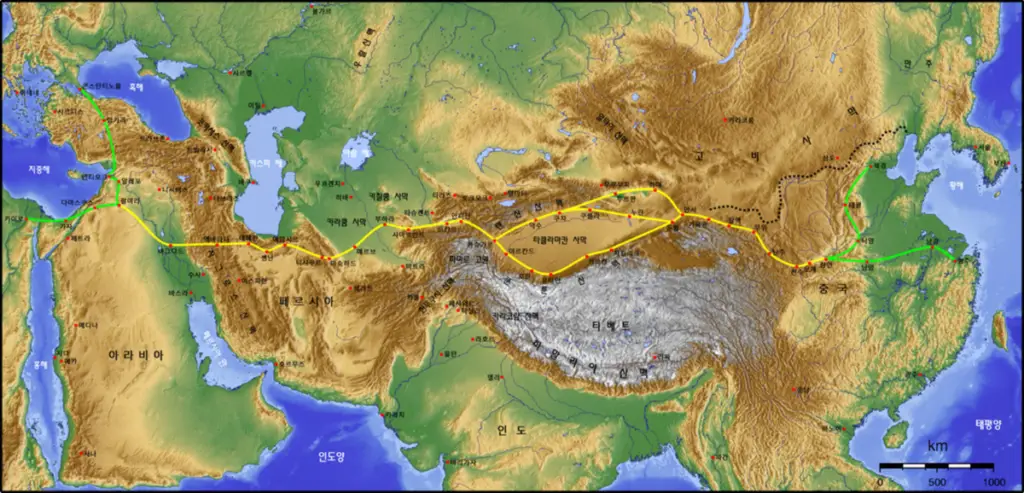|
Getting your Trinity Audio player ready...
|
The first road was not built to connect cities or to make travel easier. It was built to transport the mighty armies of ancient Mesopotamia. It was the backbone of a civilisation, the artery that pumped life into the heart of an empire. But who built the first road and in which country?
Who built the first road puzzled historians for centuries. But the answer lies in the desert sands of present-day Iraq. The first road was built over 6,000 years ago by the Sumerian people. It was a marvel of engineering, and a feat of human ingenuity. And it marked the start of an era in transportation and civilisation.
This article journeys through time, to uncover the history of the first road, and its impact on the modern world .
Who Built the First Road – The History of Road Development
Roads have become a metaphor for progress, knowledge, adventure, exploration, and expansion. And the word has been used in countless idioms, poems, and songs. But we won’t go down that road- that long and winding road. Instead, let’s look at the evolution of one of mankind’s most important inventions. Then its development from simple beginnings in Mesopotamia to sophisticated modern-day constructions.
How Roads evolved
For some time, the ancient peoples who built their towns and cities around water had little use for roads. The Nile, Tigris, and Euphrates rivers, along with the Mediterranean and Arabian Seas, lakes, canals and minor rivers all seemed perfectly adequate for transportation and trading. But as communities grew, so did their need for roads, as we shall see.
The Pyramid Influence
When the Egyptians began building their pyramids, roads made it easier to transport the heavy stone blocks from the quarry to the construction site. The Lake Moeris Quarry Road is the oldest surviving paved road in the world. At 7.5 miles (11km) long, it connected the basalt quarry to Lake Moeris. From where they were able to float the stones down the river Nile to Cairo when it flooded.
The Roman Influence

The Romans took road engineering to another level with a sophisticated network of almost 53,000 miles (85,300 km) of expertly constructed stone paved roads. And many are still in existence today.
While Europe during the Dark Ages saw a decline in innovation and a return to dirt roads, the Middle East was enjoying its Golden Age. A little work in improving their bitumen (distilled tar) found that when poured over their stone roads, it became hard and durable – something the West didn’t discover until the Champs-Elysees, Paris was tarred in 1824.
The Industrial Revolution effect.
With the Industrial Revolution came a renewed interest and understanding in the science behind a well-constructed road. The Scottish engineer John McAdam created the precursor to the modern road called macadamisation – crushed stones of a specific size mixed with tar – from which we get the word tarmacadamshortened to tarmac.
In 1901, the British engineer Edgar Hooley patented the mixture of tar and stone and added cement and resin. Using a steam roller, he was able to spread it out more thinly. Today, our roads are made of petroleum-derived asphalt and gravel. But the future may see a dramatic change in the way we make our roads. Already there are roads made from recycled plastic, so, solar powered streets and photoluminescent lanes may soon be a common sight.
The Importance of Roads in Ancient Civilisations.

Roads were essential for traders and merchants to move easily. Rather than relying on mules and donkeys, wheeled carts enabled bigger loads to be carried between towns that did not have the benefit of a nearby river or sea.
But as empires grew, their large armies of soldiers needed to move swiftly between the territories, and well-built roads reduced the time and difficulty of their march. Without these roads, mighty armies would never have reached the far-flung corners of the world. And if they had not conquered the lands they did, ancient cultures would have looked very different.
The First Road in Mesopotamia
Mesopotamia is often referred to as the Cradle of Civilisation. The first farmers, the first to use the wheel, first to use a written language, and as far as we know, the first to build a road.
When nomadic tribes stopped wandering the trodden paths in search of food and settled down in the fertile crescents of Mesopotamia to farm the land, carts with wheels and the first dirt roads emerged. With growing communities came leadership and power and it wasn’t long before they cultivated a desire to expand into new territories. Modern-day Iraq was once home to the great Sumerian civilisation and later the Babylonian and Assyrian empires. Thousands of years of conflict to gain control of the lands meant there was a mighty military presence. By 4000 BC, the first stoned paved roads of Ur and Babylon were constructed to carry the armies.
The Construction Techniques used by the First Road Builders
The Sumerians built their roads from stones while the Babylonians more commonly use dried mud brick set in bitumen. Metallurgy played a big part in the construction techniques used by the first road builders. And the stronger and sharper tools of the Bronze Age meant they could hone better shaped and smoother stones. The Minoans on the island of Crete built their roads from sandstone cobbled together with mortar. Whereas the oldest known roads in England were made of logs.
The Roman roads brought a more structurally sound surface to support legions of soldiers. But their genius came not from invention but from improvement. They perfected the skills learned before them from other cultures and empires.
- Cement technology was drawn from the Etruscans,
- stonework from the Greeks,
- pavement structure from the Carthaginians, and
- surveying from the Egyptians.
Their use of cement and layers of materials, and their understanding of drainage and weight distribution gave them the well-earned reputation as sophisticated engineers.

The Significance of the First Road in Mesopotamia
It is no coincidence that the first paved roads coincided with the first cuneiform writings in Mesopotamia. With an expanding culture and community came the necessity for communication. Both roads and the written word made communication faster and more effective. Roads made alliances with neighbouring kingdoms and their armies possible. It worked well for many centuries before the Assyrian rise to power in the 18th century BC.
The Impact of the First Road on Growth and Development
The First Road had a significant impact on Growth and Development in Mesopotamia.
The Assyrians in the north of Mesopotamia conquered and expanded their empire to become the largest the world had ever seen. But unlike the Sumerians and Babylonians before them who were more concerned with the spread and development of civilisation, the Assyrians were motivated by military conquests and the expansion of territory.
With the spread of the Assyrian empire came the diffusion of the Akkadian language, bringing kingdoms together and making trade easier. More roads were made to connect the cities which in turn encouraged development as well as the construction of impressive architecture.
The First Road’s Influence on Transportation and Communication
Whether it was by trading or invading, cultures merged and communities were enriched when roads connected them.
The exchange of
- languages,
- craft techniques,
- technology,
- food products and
- socio-political ideas
was undeniably influential on the development of civilisation as we know it today.

Many trade routes sprung up over the millennia since the first roads over 6000 years ago. They played an integral part in the shaping of countries and borders on the world map. the Roman Empire’s far-flung transportation network had a mighty influence. It extended from Britain across the Mediterranean and northern Africa to the Middle East. And with the Silk Road that wove its way from Europe to China, modern civilisation was created.
It is little wonder the road has become a metaphor of the human experience. As the journey of every person, the road tells of where we’ve been and where we’re going. It is a symbol of choices, challenges and changes in our lives.
Final Thoughts
The first road built in ancient Mesopotamia stands as a testament to the human desire to connect, to communicate, and to conquer. It was a symbol of power and progress, a road that led to the rise of one of the world’s first great civilisations. It was the foundation on which the transportation and communication systems of the ancient world were built.
The first road was not just a path of dirt and stone. It was the birth of a new era, the beginning of a journey that would shape the course of human history. It may have been built to transport armies, but the road ended up transporting ideas, goods, and people.
The legacy lives on in the roads that we use every day. It is a reminder that even in the most harsh and unforgiving of environments, human ingenuity and determination can achieve things that may at first seem impossible.
FAQs
Q: Who built the first road?
A: The first road was built in ancient Mesopotamia, which is present-day Iraq by the Sumerians.
Q: When was the first road built?
A: The first road was built over 6,000 years ago.
Q: What was the purpose of the first road?
A: The first road was built to transport the armies of ancient Mesopotamia.
Q: What impact did the first road have on the growth and development of Mesopotamia?
A: The first road had a significant impact on the growth and development of Mesopotamia. It enabled the transportation of armies, goods, and people, and it facilitated communication between different parts of the empire.
Q: How did the first road influence the development of transportation and communication in ancient civilizations?
A: The first road in Mesopotamia marked the beginning of a new era in transportation and communication. It served as a foundation for the development of transportation and communication systems in other ancient civilisations.
Why not Join Us
If you enjoyed this article, we would like to offer you two gifts – our Starter Pack of 4 James King’s books and our Weekly Digest, which you can receive by email.

